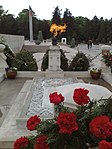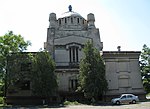City Mall (Bucharest)
Shopping malls in Bucharest
City Mall was a shopping mall located in Eroii Revolutiei square, Bucharest, Romania. Opened in 2005, the construction was based on an incomplete hunger circus abandoned after the fall of the Communist system.The mall became insolvent in 2012, and was bought by real estate investor Ioannis Papalekas. In March 2013, Papalekas announced plans to convert the mall into an office building.
Excerpt from the Wikipedia article City Mall (Bucharest) (License: CC BY-SA 3.0, Authors).City Mall (Bucharest)
Șoseaua Olteniței, Bucharest Berceni (Sector 4)
Geographical coordinates (GPS) Address External links Nearby Places Show on map
Geographical coordinates (GPS)
| Latitude | Longitude |
|---|---|
| N 44.401666666667 ° | E 26.097777777778 ° |
Address
City Offices
Șoseaua Olteniței
041341 Bucharest, Berceni (Sector 4)
Romania
Open on Google Maps









